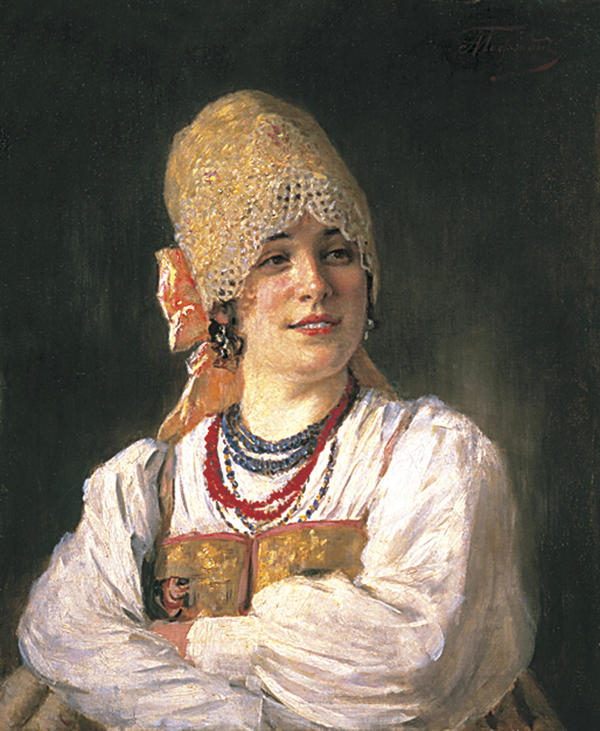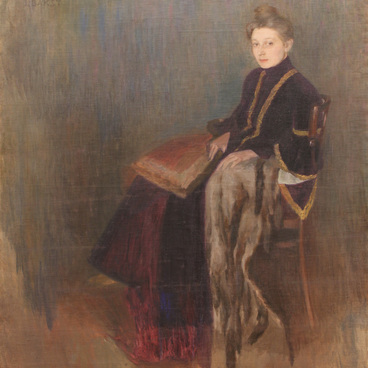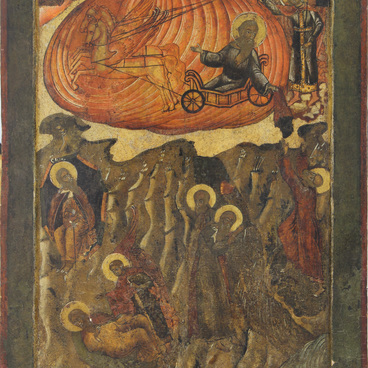#1

Hoffman A.E.
Merry Wife
#3
#2
The Merry Wife portrait was painted by artist Alexander Hoffman. His name is rarely mentioned in art books, information about the artist varies, and even the date of his death is indicated approximately. The little that is known about him is that he lived in two capital cities of Russia: he studied at the Imperial Academy of Arts in 1881-1887, and later at the Moscow School of Sculpture and Architecture. In Moscow, Hoffmann lived until 1904, where he was busy painting landscapes and portraits and often participated in art exhibitions.
#4
About the picture
#5
He did the Merry Wife a bit earlier, in the 1890s.
The woman in the portrait stands with folded hands and a trace of a haughty smile on her face. She is dressed in a national costume, embroidered with gold and pearl threads. The artist delicately wrought out the face, the complex headpiece with a bow, the coral and sapphire bead necklaces, while the sweeping strokes of the white paint over smoky shades helped to visually convey the texture of the starchy shirt. The artist had one of his models to pose for him, while the costume elements were obtained from antiquity collectors.
The woman in the portrait stands with folded hands and a trace of a haughty smile on her face. She is dressed in a national costume, embroidered with gold and pearl threads. The artist delicately wrought out the face, the complex headpiece with a bow, the coral and sapphire bead necklaces, while the sweeping strokes of the white paint over smoky shades helped to visually convey the texture of the starchy shirt. The artist had one of his models to pose for him, while the costume elements were obtained from antiquity collectors.
#6
‘Costumed’ portraits
#7
Such ‘costumed’ portraits were popular at the time. The paintings often depicted boyars and merchants in rich apparel: brocade painted caftans and sarafans, sable fur coats, gem-incrusted hats and kokoshniks. The motifs of such paintings were similar; artists usually pictured spectacular feasts, folk games and festivities. This direction in art was supported by Emperor Alexander III himself, who often bought such canvases.
Due to the rich décor in the composition, with its gold elements, gems and furs, as well as a simplified motif, ‘boyar’ paintings were soon referred to as ‘salon painting’. At that time, the concept of ‘salon painting’ included not only works of art, which were displayed at the Paris Art Salon, but also canvases focusing largely on the aesthetics of images, the external ‘beauty’ but not psychologism.
#8
For a long time Merry Wife was held in a private collection. In 1996, it was acquired by the Khanty-Mansiysk Autonomous Okrug Generations Fund at the Alpha Art auction in Moscow. In 2011, Merry Wife was transferred to the collection of the State Museum of Fine Arts of Khanty-Mansiysk.
#9
State Museum of Fine Arts of Khanty-Mansiysk
читать дальшескрыть
00:00
00:00
1x
Merry Wife
Время создания
1890s
Размер
64x53 cm
Техника
Сanvas, oil on canvas
2
Открыть в приложении
Поделиться


